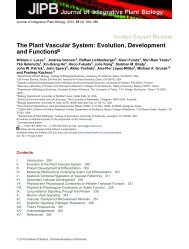Zygomorphy and heterandry in Solanum in a phylogenetic context
Zygomorphy and heterandry in Solanum in a phylogenetic context
Zygomorphy and heterandry in Solanum in a phylogenetic context
Create successful ePaper yourself
Turn your PDF publications into a flip-book with our unique Google optimized e-Paper software.
3. <strong>Solanum</strong> sect. Nycterium. All molecular <strong>phylogenetic</strong> studies to date that have<br />
sampled these species (Olmstead <strong>and</strong> Palmer, 1997; Lev<strong>in</strong> et al., 2006; Weese <strong>and</strong> Bohs,<br />
2007), <strong>in</strong>clud<strong>in</strong>g this one, conclusively show that S. tridynamum is not closely related to<br />
S. vespertilio <strong>and</strong> S. lidii, <strong>in</strong> concordance with their morphological <strong>and</strong> biogeographical<br />
differences. <strong>Solanum</strong> vespertilio <strong>and</strong> S. lidii are sister taxa <strong>and</strong> occur on a clade with a<br />
number of African sp<strong>in</strong>y <strong>Solanum</strong> species from subgenus Leptostemonum. Although the<br />
Canary Isl<strong>and</strong> taxa are part of a well-supported clade <strong>in</strong>clud<strong>in</strong>g S. aethiopicum, S. anguivi,<br />
S. capense, S. cyaneopurpureum, S. hastifolium <strong>and</strong> S. tomentosum, <strong>in</strong> Fig. 4 <strong>and</strong> <strong>in</strong> the<br />
analyses of Lev<strong>in</strong> et al. (2006), sampl<strong>in</strong>g is not sufficiently dense among the African<br />
sp<strong>in</strong>y solanums to confidently establish the sister taxa to S. vespertilio <strong>and</strong> S. lidii.<br />
However, the African sp<strong>in</strong>y solanums sampled <strong>in</strong> this clade all have act<strong>in</strong>omorphic,<br />
isantherous, five-merous flowers <strong>and</strong> lack enantiostyly (Fig. 3I). The breed<strong>in</strong>g systems<br />
<strong>and</strong> degree of <strong>and</strong>romonoecy are not well known <strong>in</strong> the African species of <strong>Solanum</strong> <strong>and</strong><br />
should be <strong>in</strong>vestigated <strong>in</strong> the future for comparison with the Canary Isl<strong>and</strong>s taxa.<br />
<strong>Solanum</strong> tridynamum is strongly supported as sister to the Mexican S. h<strong>in</strong>dsianum<br />
<strong>and</strong> <strong>in</strong> turn these two are sister to S. elaeagnifolium, a species with a disjunct distribution<br />
<strong>in</strong> North <strong>and</strong> South America. <strong>Solanum</strong> h<strong>in</strong>dsianum <strong>and</strong> S. elaeagnifolium are<br />
<strong>and</strong>romonoecious, with act<strong>in</strong>omorphic, five-merous, isantherous flowers (or sometimes<br />
with subequal anthers <strong>in</strong> S. h<strong>in</strong>dsianum; Fig. 3L). <strong>Solanum</strong> h<strong>in</strong>dsianum has the splash-cup<br />
or censer fruit type found <strong>in</strong> S. tridynamum, but S. elaeagnifolium has a dryish yellow<br />
berry. The breed<strong>in</strong>g system of S. elaeagnifolium has not been reported, but greenhouse<br />
cross<strong>in</strong>g studies <strong>in</strong>dicate that S. h<strong>in</strong>dsianum is self-<strong>in</strong>compatible (L. Bohs, unpubl. data).<br />
If the sister relationship between S. tridynamum <strong>and</strong> S. h<strong>in</strong>dsianum is confirmed<br />
upon further study, this species pair may be a useful system for the evolution of derived<br />
floral morphologies <strong>in</strong> <strong>Solanum</strong>. The flowers of the two species are radically different <strong>in</strong><br />
appearance <strong>and</strong> present opportunities to exam<strong>in</strong>e the genetic control of heteranthery <strong>and</strong><br />
stylar heteromorphism <strong>in</strong> sister taxa. Furthermore, s<strong>in</strong>ce S. h<strong>in</strong>dsianum appears to be self<strong>in</strong>compatible,<br />
the question is raised of whether the extreme floral forms seen <strong>in</strong> S.<br />
tridynamum evolved <strong>in</strong> response to the loss of self-<strong>in</strong>compatibility <strong>in</strong> ancestral<br />
populations of this species.<br />
Other Heterantherous <strong>Solanum</strong>s<br />
Aside from the focal groups, several <strong>Solanum</strong> species were sampled that have a<br />
s<strong>in</strong>gle long stamen <strong>in</strong> the flower; these are <strong>in</strong>dicated on Fig. 4. This morphology has<br />
evolved multiple times <strong>in</strong> <strong>Solanum</strong>: at least three times <strong>in</strong> the sampled species <strong>and</strong> at least<br />
once more <strong>in</strong> the Gem<strong>in</strong>ata clade, represented here by S. pseudocapsicum, S. arboreum,<br />
<strong>and</strong> S. argent<strong>in</strong>um but without sampl<strong>in</strong>g any taxa <strong>in</strong> the Gem<strong>in</strong>ata group with unequal<br />
stamens.<br />
Functional Aspects of Heteranthery <strong>in</strong> <strong>Solanum</strong> Poll<strong>in</strong>ation<br />
The biological significance of heteranthery, floral zygomorphy <strong>and</strong> enantiostyly <strong>in</strong><br />
<strong>Solanum</strong> poll<strong>in</strong>ation is still imperfectly known. The most thoroughly studied species from<br />
a functional po<strong>in</strong>t of view is S. rostratum (section Androceras), which is zygomorphic,<br />
markedly heterantherous, <strong>and</strong> has monomorphic enantiostyly, where the style is deflected<br />
to the side of the flower opposite the long anther. Successive flowers <strong>in</strong> an <strong>in</strong>florescence<br />
are alternat<strong>in</strong>gly right- <strong>and</strong> left-h<strong>and</strong>ed. Bowers (1975) studied the poll<strong>in</strong>ation biology of<br />
this species <strong>and</strong> found that while bees grasped <strong>and</strong> buzzed the four short anthers <strong>in</strong> the<br />
flowers, pollen from the s<strong>in</strong>gle long anther was deposited under the bee’s w<strong>in</strong>g on one<br />
side where it could not easily be groomed off. The deflected style picks up pollen<br />
deposited on the bee by the long anther. Depend<strong>in</strong>g on the bee visitation patterns <strong>and</strong> the<br />
number of open flowers on a plant at any one time, pollen can be moved between flowers<br />
of a s<strong>in</strong>gle plant (geitnogamy) or between separate plants (xenogamy), but self-poll<strong>in</strong>ation<br />
is greatly reduced <strong>in</strong> this syndrome.<br />
Jesson <strong>and</strong> Barrett (2002, 2005) performed the most thorough experimental<br />
analysis of the functional aspects of enantiostyly, aga<strong>in</strong> utiliz<strong>in</strong>g S. rostratum as the<br />
208
















